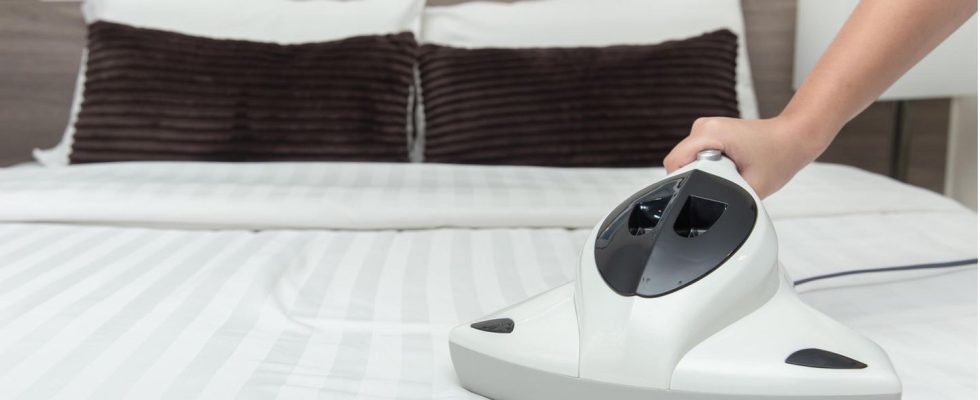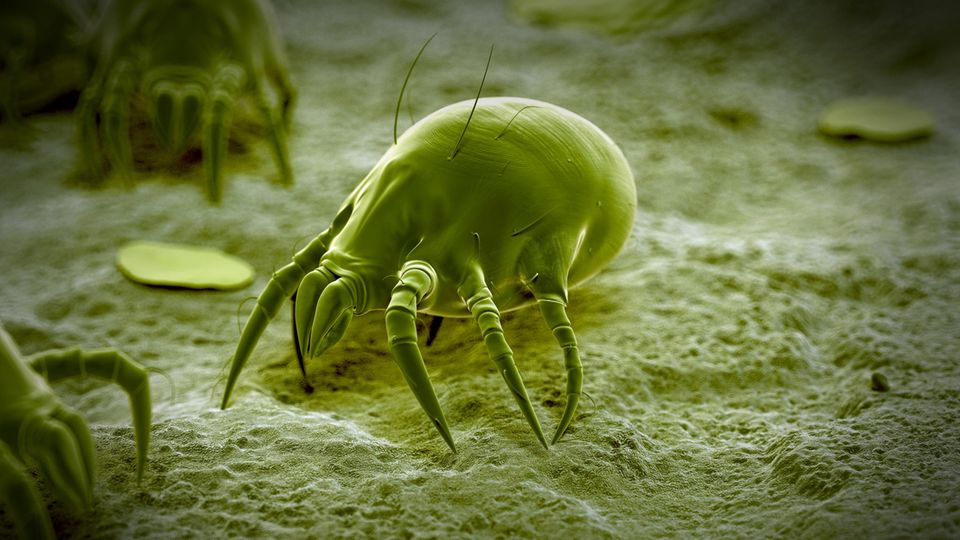House dust allergy
Fighting mites: How to reduce infestation in the bedroom
UV-C light can reportedly remove up to 99.9% of all mites
© coffeekai / Getty Images
Mites are so small that we cannot see them with the naked eye. And yet they are there: In every household there are millions of arachnids that feed on human skin flakes. They pose no health risk – unless you suffer from a house dust allergy.
Typical signs of a house dust mite allergy are itchy, watery or red eyes. There are also violent sneezing attacks and a runny nose, and in the worst case scenario, coughing or chronic asthma. The symptoms are not triggered by the 0.1 millimeter large arachnids, but by their excretions and body remains. These are mainly found in bed, as mites prefer a warm, humid environment. However, their presence has nothing to do with poor hygiene – allergy sufferers can still take measures to reduce the infestation and thus the symptoms.
Take action: How to prevent mites
Ventilate properly
Since mites prefer a warm, humid environment, the bedroom should always be cool and dry. To reduce humidity, you need to ventilate the room regularly (once or twice a day) – the best way to do this is to open a window completely for several minutes. Also make sure that it is never warmer than 20 degrees in your bedroom. It is also helpful if the mattress can air out in the morning, as we sweat a lot at night. So instead of making the bed every morning, leave it uncovered.
Change bed linen
Although mites are not a sign of poor hygiene, it is advisable to change the bed linen regularly – ideally every four weeks, and even more frequently in the warm summer months. The blankets and pillowcases used should be washed at at least 60 degrees, as the arachnids can survive low temperatures. Other textiles such as carpets, in which mites also reside, can be hung in the garden or on the balcony in the sun for a few hours.
Use mattress protectors
Mattresses are difficult to clean: Even if the cover is removable, it often doesn’t fit in a regular washing machine and has to be taken to be cleaned. To save time and money, you can choose a waterproof and breathable one instead mattress protector insert. It is available in different sizes and is simply placed between the mattress and the bed sheet. Of course there are also special ones for allergy sufferers encasings – this refers to mite-proof protective covers.
Vacuum regularly
Where there is dust, there are also mites. Not just in bed, but also on the floor. In order to control the population, it is advisable to vacuum the bedroom regularly – or even mop it if the floor allows it. Hard-to-reach areas can be cleaned with a feather duster and dusty surfaces can be wiped with a damp cloth. There is also a special vacuum cleaner for allergy sufferers Hepa hygiene filter which can filter more than 99.5 percent of all particles from the air.
Reduce infestation: These tools are available
Protective covers
There are special protective covers not only for the mattress, but also for Cover and Pillow: So-called encasings (“to encase” means “to cover”) were developed for allergy sufferers who react to house dust mites. The mite-proof covers are intended to keep the arachnids and their excreta trapped between the blanket and the cover so that they cannot cause any symptoms. However, it is important to know that the encasings also need to be washed regularly.
air cleaner
Air purifiers are also equipped with a so-called Hepa filter (High-Efficiency Particulate Air/Arrestance). According to the manufacturer, the devices should be able to remove up to 99.5 percent of the allergens that are most often found in the air. The AC0820/10 from Philips for example, filters viruses, aerosols, pollen, dust, bacteria and ultrafine particles down to a size of 0.003 micrometers (μm) from the air. This can reduce typical complaints such as itchy eyes and runny nose.
Mite spray
This is an effective biocide that you can use to combat mites: The contact spray with geraniol kills the arachnids and fixes them on the mattress, but does not remove them. Talk to someone after treatment Mite spray you still need to vacuum the treated surfaces thoroughly. You should repeat this process at least every four to six weeks to prevent the mite population from spreading further.
Mite vacuum cleaner
As an alternative to the air purifier, there are also special ones Mite vacuum cleaner for mattresses, duvets and pillows: They sterilize the surface with UV-C light, which kills 99.9 percent of the arachnids (as the manufacturer claims). At the same time, the device sucks in the mites and their residue and – thanks to the Hepa filter – no longer lets them out of the dust container. In addition, the mite vacuum also removes germs, bacteria, pathogens and fungi.
And another note: If you can no longer get the mite problem under control, it makes sense to replace the old mattress with a new one – this is generally recommended after five to eight years.
Dust mites are microscopic and cannot be seen with the naked eye
© SciePro/Getty Images
Fight mites: The best home remedy
As an alternative to the tools mentioned, you can of course also use a tried and tested home remedy: Tea tree oil. It has a disinfectant effect and is intended to combat mites – using this method: Take 30 milliliters of liquid and fill it with clear water into a standard spray bottle. Mix the contents and then apply it to the desired surfaces such as upholstered furniture or carpets. You can also use tea tree oil for the bed including the mattress, blankets and pillows, but you should keep in mind that the smell can be very dominant and is not to everyone’s taste.
And one more tip at the end: You can also add tea tree oil to your mopping water when cleaning the floor.
Source: Utopia
You might also be interested in:
This article contains so-called affiliate links. Further information are available here.



